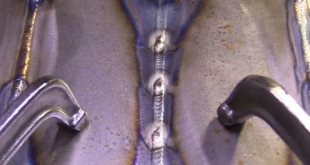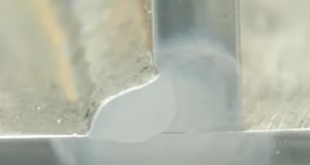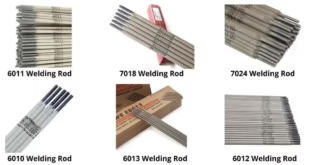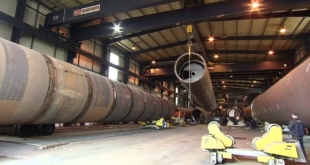Welding Super Duplex Stainless Steel
Super duplex stainless steels (SDSS) sit at the high-performance end of stainless metallurgy: they pair very high strength with excellent resistance to localized corrosion (pitting and crevice) in chloride-bearing environments. Because of that combination they’re widely used in aggressive process environments — think oil & gas subsea hardware, chemical process equipment, heat exchangers and coastal energy structures. For welders and fabricators, SDSS offers great performance — but also demands careful welding practice. This article explains what makes SDSS special, why welding it is different from welding ordinary austenitic stainless steels, and provides practical, shop-ready guidance for producing robust, corrosion-resistant welds.
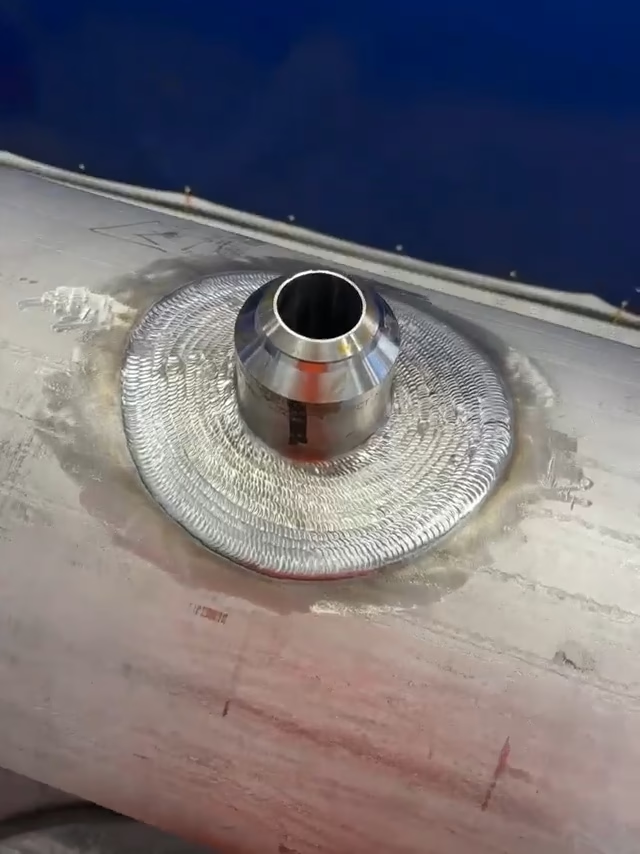
What is Super Duplex Stainless Steel?
Chemical composition and key alloying elements
Super duplex steels are a family of stainless steels with a duplex (two-phase) microstructure: roughly balanced ferrite (body-centered cubic) and austenite (face-centered cubic). What makes them “super” is the elevated content of alloying elements that increase corrosion resistance and strength — in particular chromium (Cr), molybdenum (Mo) and nitrogen (N). Typical compositions are in the order of ~24–26% Cr, ~6–7% Ni, ~3–4% Mo and elevated nitrogen (~0.2–0.4%). These alloying additions give SDSS substantially higher pitting resistance than standard 300-series stainless steels.
Common grades and designation (UNS / trade names)
Familiar grades in the super duplex family include alloys marketed under trade names or UNS numbers; these grades are chosen for subsea and chloride-rich conditions where both strength and localized corrosion resistance matter. (When specifying materials for fabrication or repair, use the exact UNS or supplier designation in procurement and the WPS.)
PREN (Pitting Resistance Equivalent Number) and why it matters
PREN is a simple index used to estimate resistance to pitting corrosion in chloride environments. A common formula is:
PREN = %Cr + 3.3 × %Mo + 16 × %N
Higher PREN numbers indicate better pitting resistance. Super duplex grades typically have PRENs well above conventional austenitic stainless steels — a primary reason they are chosen for aggressive environments.
Mechanical and Corrosion-Resistant Properties
Strength and toughness
One of SDSS’s strengths is its high yield and tensile strength — often roughly double that of ordinary austenitic stainless steels. This allows designers to use thinner sections for the same load, saving weight and material cost. Importantly, SDSS also retains respectable toughness down to moderate low temperatures, but welds must be made carefully to avoid embrittlement from unwanted phases.
Temperature / service limits
SDSS performs well over a wide temperature range, but its corrosion resistance and microstructural stability must be considered when components operate at elevated temperatures or when welds experience slow cooling through critical temperature ranges where intermetallics form.
Corrosion behaviour: pitting, crevice and chloride SCC
The high Cr, Mo and N contents make SDSS highly resistant to localized corrosion — particularly pitting and crevice corrosion. They’re also far more resistant to chloride stress corrosion cracking (CSCC) than 300-series stainless steels, though careful material and weld control is still essential in aggressive environments.
Metallurgy and Welding Behaviour
Duplex microstructure: ferrite–austenite balance and formation on cooling
During solidification, SDSS weld metal typically solidifies as delta ferrite and then partially transforms to austenite on cooling. The final balance of ferrite and austenite depends on filler chemistry, heat input and cooling rate. A roughly 50/50 balance gives the best trade-off between strength and corrosion resistance; too much ferrite reduces toughness and corrosion resistance, too much austenite reduces strength.
Intermetallic phases — sigma, chi, Laves
A major welding risk is the formation of intermetallic phases (sigma, chi, Laves) if material is held for too long in the range roughly between 600–1,000 °C. These phases deplete chromium and molybdenum from the matrix, embrittle the structure and sharply reduce corrosion resistance. Avoiding their formation is a central theme of good welding practice with SDSS.
Role of nitrogen
Nitrogen promotes austenite formation and significantly boosts pitting resistance and strength. It’s therefore a valuable alloying addition in SDSS, but nitrogen can be lost during welding unless suitable filler metal chemistry and shielding practices are used.
Primary Welding Challenges with Super Duplex
Maintaining phase balance in HAZ and weld metal
Because the desirable properties depend on a balanced microstructure, controlling heat input and filler chemistry to maintain correct austenite/ferrite proportions in the weld and heat-affected zone (HAZ) is critical.
Avoiding intermetallic precipitation and loss of corrosion resistance
Slow cooling, excessive heat input, or repeated thermal cycling can give intermetallic formation. Fabricators must control welding parameters, interpass temperature and minimize re-heating of welds to prevent these detrimental phases.
Distortion, residual stress and hydrogen-related cracking risks
SDSS’s high strength makes residual stresses and distortion more consequential. Also, hydrogen pickup from contamination can promote cold cracking; contamination control and proper pre-weld cleaning are vital.
Welding Processes & When to Use Them
GTAW (TIG)
GTAW gives excellent control over heat input and weld puddle chemistry, making it ideal for root and thin-section welds. Use backing gas or purge strategies for full penetration welds to avoid internal contamination.
GMAW (pulsed MIG)
Pulsed GMAW is commonly used for SDSS where productivity is required while still controlling heat input and metal transfer. Pulsed modes reduce heat input per unit length compared with conventional spray transfer.
SMAW, FCAW and SAW
SMAW can be used for site repair and thick sections if proper electrodes are chosen and parameters strictly controlled. SAW is effective for long, thick girth welds (shop environment) but requires strict control of flux and heat input to avoid unwanted microstructures.
Process selection by thickness and joint type
Choose process by thickness, required deposition rate, access, and ability to control heat input. For thin walls and critical root passes use GTAW; for production runs and thicker plates consider pulsed GMAW or SAW with matching filler.
Filler Metals and Consumables Selection
Matching vs over-alloyed filler metals
Filler metal should be chosen to:
Preserve a balanced microstructure in the weld metal.
Match or slightly exceed the alloying and PREN of the base metal for corrosion performance.
Provide enough nickel to promote austenite formation (if necessary).
Shielding gases and flux choices
Use high quality shielding gas mixtures recommended for duplex welding (inert or small additions to control heat and composition). Ensure welding fluxes (if used) are compatible and free of chlorides or contaminants.
WPS / Welding Parameters and Heat-Input Management
Heat input, cooling rate and phase balance
Heat input must be carefully controlled: too low → excessive ferrite (lower corrosion resistance/toughness); too high or too slow cooling → greater austenite but increased risk of intermetallic precipitation. The goal is a controlled heat input window that produces a weld metal close to the target phase balance and cools sufficiently quickly to avoid sigma formation.
Interpass temperature, preheat and travel speed guidance
Interpass temperature: keep low enough to avoid prolonged exposure to sigma-forming ranges. Many procedures recommend conservative interpass limits; check the WPS and supplier recommendations.
Preheat: minimal or none is generally used; avoid high preheat that slows cooling.
Travel speed: use travel speeds that produce the desired heat input — in practice, faster travel reduces heat input and speeds cooling but may affect fusion; balance is required.
(Always qualify values in a WPS for the specific base metal, thickness and joint.)
Pre- and Post-Weld Treatments
Cleaning, fit-up and contamination control
SDSS is sensitive to surface contamination — oil, grease, chlorides, and other residues can dramatically reduce corrosion resistance. Clean with appropriate solvents, avoid wire brushes previously used on carbon steel, and maintain good shop housekeeping. Good fit-up reduces the need for rework and additional thermal cycles.
Post-weld treatments: pickling, passivation, solution annealing
Pickling and passivation: chemical pickling (to remove heat tint and surface chromium oxide depletion) and passivation are often used after welding to restore surface performance.
Solution annealing: if intermetallic phases form (e.g., during an abnormal thermal cycle), full solution annealing at high temperature followed by rapid quench can restore microstructure — but this is an expensive shop furnace treatment and must be done per material spec. For localized repairs, local solution annealing may be possible but requires specialist equipment and control.
Inspection, Testing & Qualification
Visual, NDT, hardness and mechanical testing
Standard NDT (visual, liquid penetrant, radiography or phased-array UT) should be applied per codes and client requirements. Hardness testing in and near welds detects embrittlement from intermetallics.
Ferrite measurement, PMI and corrosion testing
Ferrite measurement (e.g., Ferritscope) verifies that the weld and HAZ have an acceptable ferrite/austenite balance.
Positive Material Identification (PMI) verifies alloy chemistry, especially important for SDSS to ensure correct PREN.
Corrosion tests: where required, pitting/crevice testing per relevant standards can be used to demonstrate service capability.
Codes, standards and WPQ/WPS considerations
Welding Procedure Specifications (WPS) and Procedure Qualification Records (PQR/WPQ) should be developed and qualified for SDSS welding operations. Many industrial codes reference specific requirements for duplex and super duplex materials — always follow project specifications and applicable standards.
Welding Dissimilar Joints & Repair Strategies
Joining to carbon steel, stainless steels, nickel alloys
When joining SDSS to carbon steel, careful design is required to avoid galvanic corrosion and to manage dilution. Often a corrosion-resistant transition layer or overlay is used. For dissimilar joints, choose filler metals and joint sequences that control dilution and thermal cycles. Stress-relief and isolation (coatings, gaskets) may be necessary in service.
Repair welding — when to rework, when to solution-anneal
Minor surface defects and porosity can be ground out and rewelded; intermetallic formation or deep intergranular attack may require removal and possible solution annealing. Always test repaired areas for microstructure and corrosion resistance if the application is critical.
Practical Shop Tips for Welders and Fabricators
Consumable handling, storage, and contamination avoidance
Store filler metals and electrodes dry and segregated. Do not use tools or brushes used on carbon steel on SDSS. Keep chlorides and contamination away from the weld area.
Joint design, backing, and fit-up best practices
Design joints to minimize the number of weld passes where possible, use backing strips or backing gas to protect the root, and control root gap to reduce dilution and ensure consistent welding conditions.
Example (Illustrative)
Below are illustrative examples — always qualify and test these on coupons and in an approved WPS for the exact material, thickness and joint:
Thin gauge (≤3 mm) — GTAW root with low heat input, short arc length, fast travel, followed by limited fill passes. Clean both sides, purge where possible.
Medium plate (3–12 mm) — Pulsed GMAW with filler designed for SDSS; moderate travel speed and controlled interpass temperature. Minimize number of reheats.
Thick sections (>12 mm) — Multi-pass SAW or pulsed GMAW in the shop; control each pass energy, avoid excessive interpass temperatures and monitor ferrite content in weld metal.
These are starting points — actual amperage, voltage and travel speed depend on joint geometry, groove preparation, and equipment.
FAQs
Can I weld super duplex stainless steel like I weld 304 stainless?
SDSS has a duplex microstructure and much higher alloy content; heat input, filler chemistry and cooling rates must be controlled to maintain phase balance and avoid intermetallics. Techniques used for 304 may produce inferior welds in SDSS.
Do super duplex welds need post-weld heat treatment?
Normal PWHT can worsen intermetallic formation if applied incorrectly. Solution annealing can restore microstructure but requires specialist furnace treatment and is not a routine shop operation. Instead, control welding to prevent phase precipitation.
How do I choose filler metal for SDSS?
The filler must compensate for dilution and ensure weld metal chemistry supports the desired ferrite/austenite balance and corrosion resistance.
What inspection is essential after welding SDSS?
These tests confirm weld integrity, acceptable phase balance, and correct alloy chemistry — all critical to long-term corrosion and mechanical performance.
What are the single most important shop practices for successful SDSS welding?
Heat input governs phase balance and intermetallic formation; contamination (chlorides, oils) undermines corrosion resistance; and a qualified welding procedure ensures repeatable, auditable quality.
Conclusion
Super duplex stainless steels are powerful engineering alloys that combine high strength and excellent localized corrosion resistance. That combination makes them invaluable for aggressive-service applications — but welding them demands attention: maintain the proper phase balance, avoid intermetallic precipitation, keep contamination and unwanted heat input to a minimum, and always qualify procedures and test welds. With controlled processes (GTAW for roots, pulsed GMAW for productive fills, careful filler selection and good shop discipline) welders can realize the full potential of SDSS in the field and the workshop. Treat SDSS as a high-value material: plan the welding, qualify the procedure, and inspect thoroughly — the payoff is a durable, high-performance component that outperforms many alternatives in hostile environments.
 Welding of Welders All about Welding and Welders
Welding of Welders All about Welding and Welders
